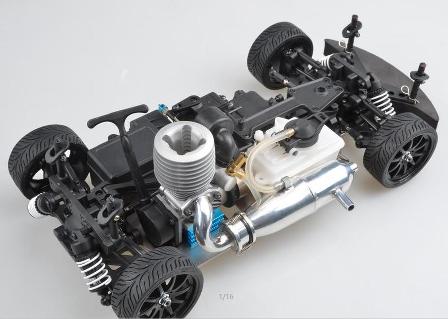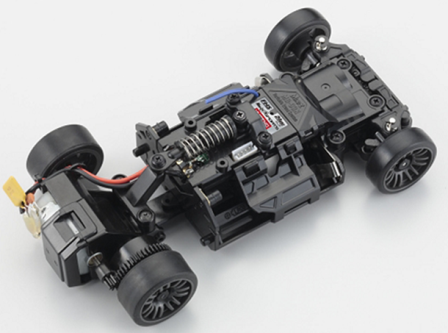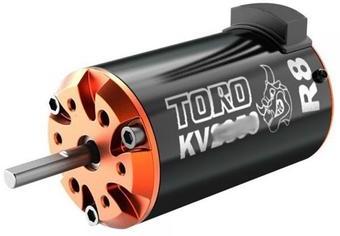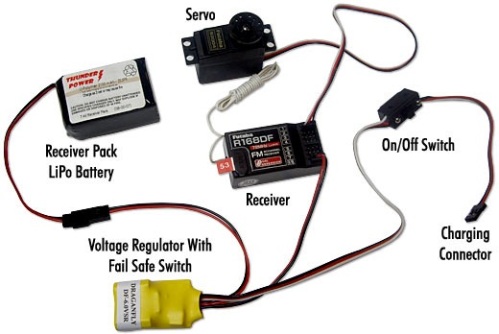Categories: How does it work
Number of views: 21963
Comments on the article: 0
How are the radio-controlled models
In recent years, radio-controlled car models have attracted increasing interest in both children and adults. It can be models on an electric motor or even on an internal combustion engine.
In the framework of this article, we will reveal the topic of the device of radio-controlled models of various types, and consider the principle of their work, so that anyone who is interested in designing their own radio-controlled models or just buying them knows what he has to deal with.

As for radio-controlled car models, first of all, you need to pay attention to the fact that the scales are very different, ranging from 1: 5 to 1:28. The most popular today are the 1: 8 and 1:10 scales, and as for the 1: 5 scale, these are very large models, which are mainly models on ICE. An internal combustion engine is larger than an electric motor.

According to the volume of cylinders, internal combustion engines are divided into classes: 12, 15, 18, 21, 25. These are numbers indicating the engine displacement in cubic inches, in accordance with the American classification. Obviously, the higher the engine class, the higher its power. So, for example, the engine power of class 15 is an average of 0.9 hp.
Internal combustion engines for radio-controlled models operate, as a rule, on a mixture of oil, methanol and nitromethane. Such fuel in cans can be purchased at stores selling radio-controlled models. Branded fuel is a guarantee of long-term engine performance.

Speaking of electric motors, it should be noted that they are usually powered by batteries accumulated in the battery, and the total battery voltage is 7.2 V or more.
In stores of radio-controlled models, such batteries are sold, both in the form of separate 1.2 V cells, and in the form of ready-made batteries of various capacities. Motors themselves are classified by the number of turns of the stator winding, usually from 10 or more, and the fewer turns, the higher the rotor speed.
The basis of the model is the chassis, because it is on the chassis that both the engine itself and the electronics are mounted and attached. Chassis are of various types, with different modifications of drives, depending on the purpose of the model. Formula 1 is usually rear-wheel drive (more often) or all-wheel drive (less often) in order to develop high speed on a flat surface.
For buggies that drive along gravel, along the sand, most often the drive is full, less often the rear. Like buggies, tracks most often use four-wheel drive. Monsters with huge wheels, mostly four-wheel drive. Road models, for driving on flat surfaces, more often with all-wheel drive.
When it comes to choosing between an electric motor or an internal combustion engine, it is important to compare all the advantages and disadvantages of both types of engines so that the choice is rational.

So, liquid fuel models are capable of developing tremendous speeds - up to 80 km / h, but think about what the accidents and head-on collisions are fraught with at such speeds. It is worth accidentally crashing into the wall, and require expensive repairs.
Do you pull regular refueling with high-quality fuel that is more expensive than gasoline? Although the engine size is small, and a 4-liter canister is enough for a long time, but still. The advantage of ICE is that the duration of the ride is quite considerable, while the sound of the engine is very realistic. Models on internal combustion engines are more expensive than models on electric motors.

From here you can see the main disadvantage of radio-controlled models on electric motors - they have a pretty fast battery, and driving on a single charge is unlikely to last more than a quarter of an hour.But models on electric motors, in comparison with models on internal combustion engines, drive very quietly, the engine is almost inaudible, there are no exhausts, high acceleration, although the speed is low. However, you have to fork out for a good battery and charger to charge from the mains or from the car cigarette lighter.
Fundamentally, the radio control of the models does not depend on scale, it is installed on the model in the Ready to run format, if you buy a model, and does not require anything from the consumer, except to pick up the remote control and start driving. However, some models are sold as a designer, and finally, someone wants to make a model on their own. Therefore, let's still consider the principle of operation of the radio control system.

In models on electric motors (as well as on models with ICE), a receiver is installed. When the trigger is pulled on the control panel or the steering wheel is turned, the receiver inside the model immediately receives the signal sent from the remote control. The signal is processed at the receiver, and the corresponding device in the design of the model is driven.
When turning the steering wheel (on the remote control), the servo drive will make the wheels turn through the rods. When you press the trigger, the speed controller will receive a signal to change the engine speed, and through the transmission (cardan or belts) the wheels will begin to rotate faster or slower. The motor, like the receiver electronics with a speed controller, is powered by a battery.
If we talk about models with ICE, then when you press the trigger of gas on the remote control, or when you turn the steering wheel on the remote control, the signal is still sent to the receiver. The receiver processes the signal, and turns on the appropriate devices.
When turning the steering wheel on the remote control, through the traction system, the servomotor will make the wheels turn. When you press the gas, the second servomotor will begin to move the carburetor shutter, and the fuel-air mixture will be fed into the cylinder by a stream of a certain volume - the speed will change. A battery is used to power the servomotors.
So, as you understand, the design of a radio-controlled model includes the following integral components: a control panel, a receiver, servos, an engine (electric or ICE), and a speed controller for electric motors. These parts are sold as kits or separately.
Let us dwell in more detail on the principle of operation of the transmitter and receiver electronics. The transmitter is in its simplest form a high-frequency generator and a low-frequency modulator. The modulator includes a high-frequency generator with a command frequency. Radiated by the remote control antenna, a modulated high-frequency signal is received by the receiver mounted on the model.
The receiver contains a low-frequency amplifier, a high-frequency cascade and an electronic relay. The high-frequency stage amplifies and detects the received signal, then the signal is filtered, and the filtered signal is fed to the input of the low-frequency amplifier. The low-frequency current of the command signal acts on the emitter follower, which causes the relay to operate in the power circuit of the corresponding motor.
In its simplest form, the radio-controlled model is able to go forward and turn, it depends, of course, on the number of servos. So, the quadrocopter can have six drives.
As for the commands, they can be transmitted both over the radio channel, and over wi-fi, and over bluetooth, and over the IR, due to the fact that the signal is always encoded after all, and does not cause interference, and the receiver easily recognizes its signal, thanks to preset.

Now let's focus on batteries for models with an electric motor. Three types of batteries are common today: Nickel cadmium, nickel metal hydride and lithium. A voltage of 7.2 V is typical for the first two types, and 7.4 volts for lithium. Lithium is now increasingly popular, their capacity reaches tens of milliampere-hours, although the price, of course, is appropriate.
As for liquid fuels, here, as mentioned above, requires a special fuel that contains nitromethane. Nitromethane enhances the return of the internal combustion engine, and the content of this component usually lies in the range of 16-25%. The oil contained in the fuel provides the engine with lubrication. The fuel canister indicates the percentage of nitromethane in the fuel, as well as the type of models for which the fuel is suitable.
The bodies are made of polycarbonate, a light and flexible material that is resistant to impacts. On sale there are models with and without a body. The body for your model can be purchased separately. Fortunately, the choice of bodies today is very large.
There are transparent and tinted options. Transparent can be painted inside with polycarbonate paint, such paint is sold in model stores. For beginners, a more elastic body is best suited, so that the management of an inexperienced driver would not lead to its rapid destruction from emergency shocks.
See also on our website:Device and programming microcontrollers for beginners
See also at bgv.electricianexp.com
:
